Research in Business: Coles's Investment Decision Analysis (Finance)
VerifiedAdded on 2021/04/21
|6
|942
|17
Report
AI Summary
This report analyzes the investment decisions related to Coles's recent business decline in Australia. It begins by outlining the problem statement, focusing on the increased competition in the Australian supermarket sector and Coles's declining market share. The study aims to determine the impact of organizational image and accounting information on individual investor behavior, evaluate Coles's financial position over the past three years, and recommend investment strategies. The methodology involves a mixed approach, including a literature review of investment decision factors and investor behavior theories (regret theory, mental accounting theory, and overconfidence theory). The research utilizes secondary data from government and industry sources, annual reports, and advocacy groups, employing ratio analysis to assess Coles's financial performance. The findings are intended to guide potential investors, offering insights into the factors influencing investment decisions in the context of Coles's market challenges.
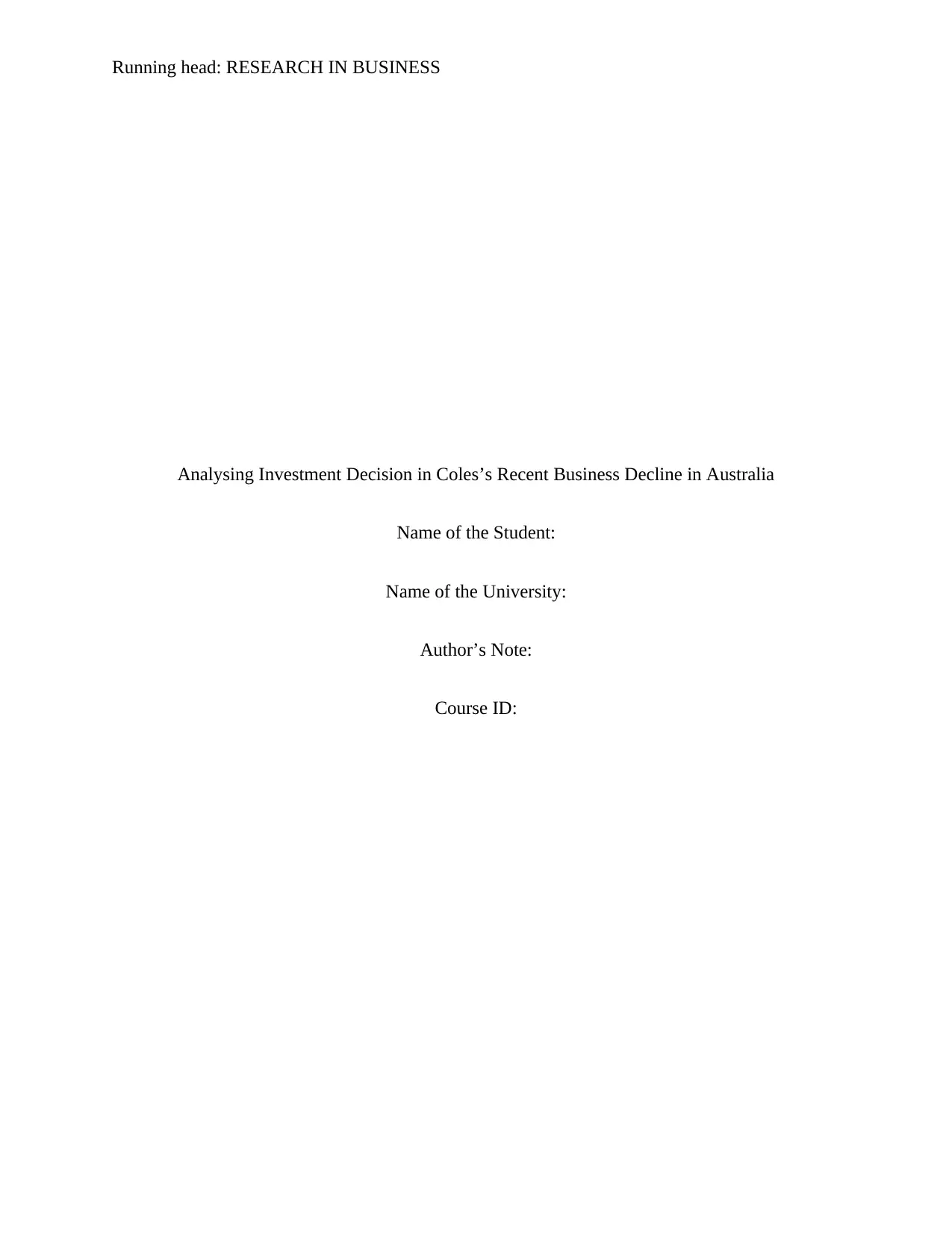
Running head: RESEARCH IN BUSINESS
Analysing Investment Decision in Coles’s Recent Business Decline in Australia
Name of the Student:
Name of the University:
Author’s Note:
Course ID:
Analysing Investment Decision in Coles’s Recent Business Decline in Australia
Name of the Student:
Name of the University:
Author’s Note:
Course ID:
Paraphrase This Document
Need a fresh take? Get an instant paraphrase of this document with our AI Paraphraser
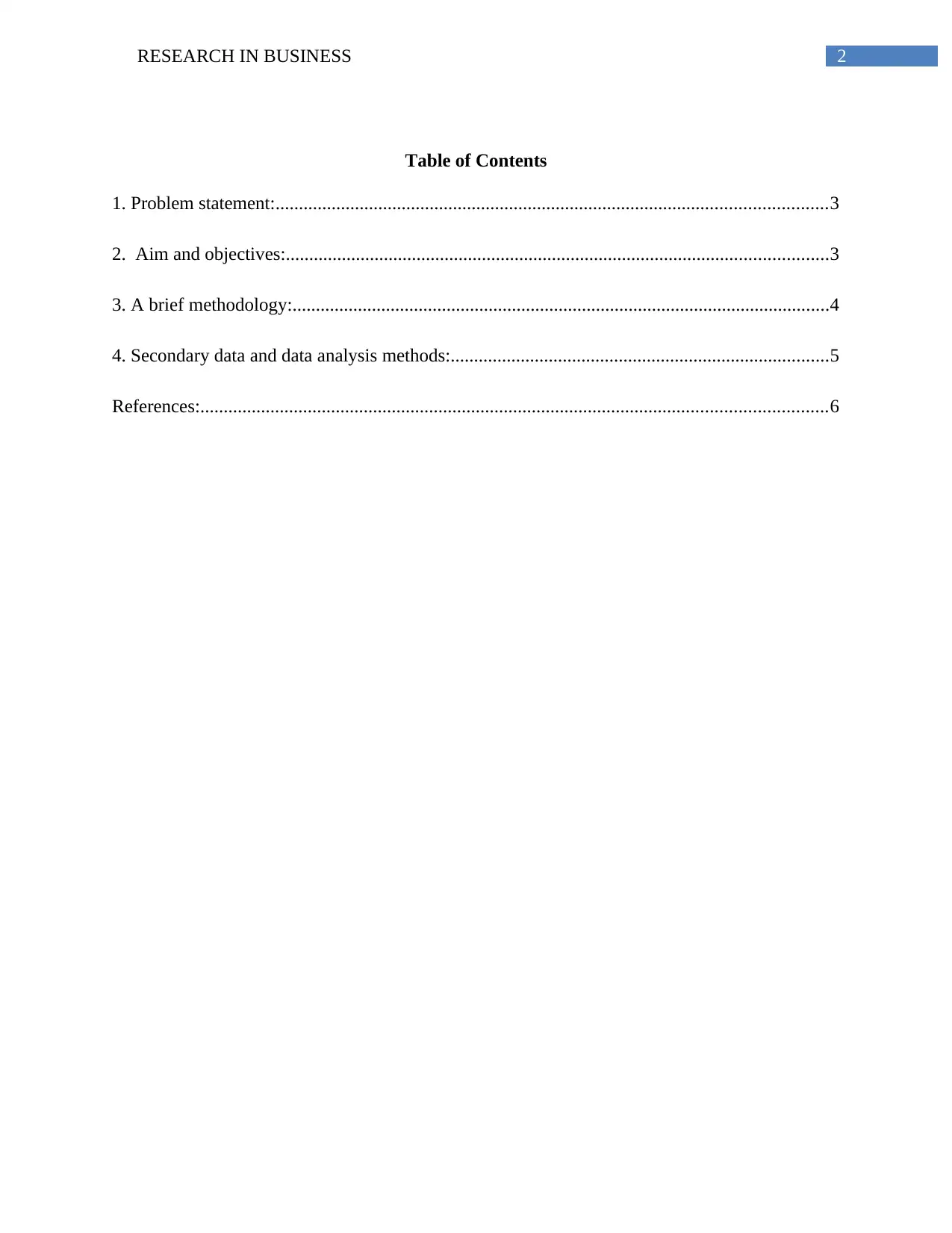
2RESEARCH IN BUSINESS
Table of Contents
1. Problem statement:......................................................................................................................3
2. Aim and objectives:....................................................................................................................3
3. A brief methodology:...................................................................................................................4
4. Secondary data and data analysis methods:.................................................................................5
References:......................................................................................................................................6
Table of Contents
1. Problem statement:......................................................................................................................3
2. Aim and objectives:....................................................................................................................3
3. A brief methodology:...................................................................................................................4
4. Secondary data and data analysis methods:.................................................................................5
References:......................................................................................................................................6
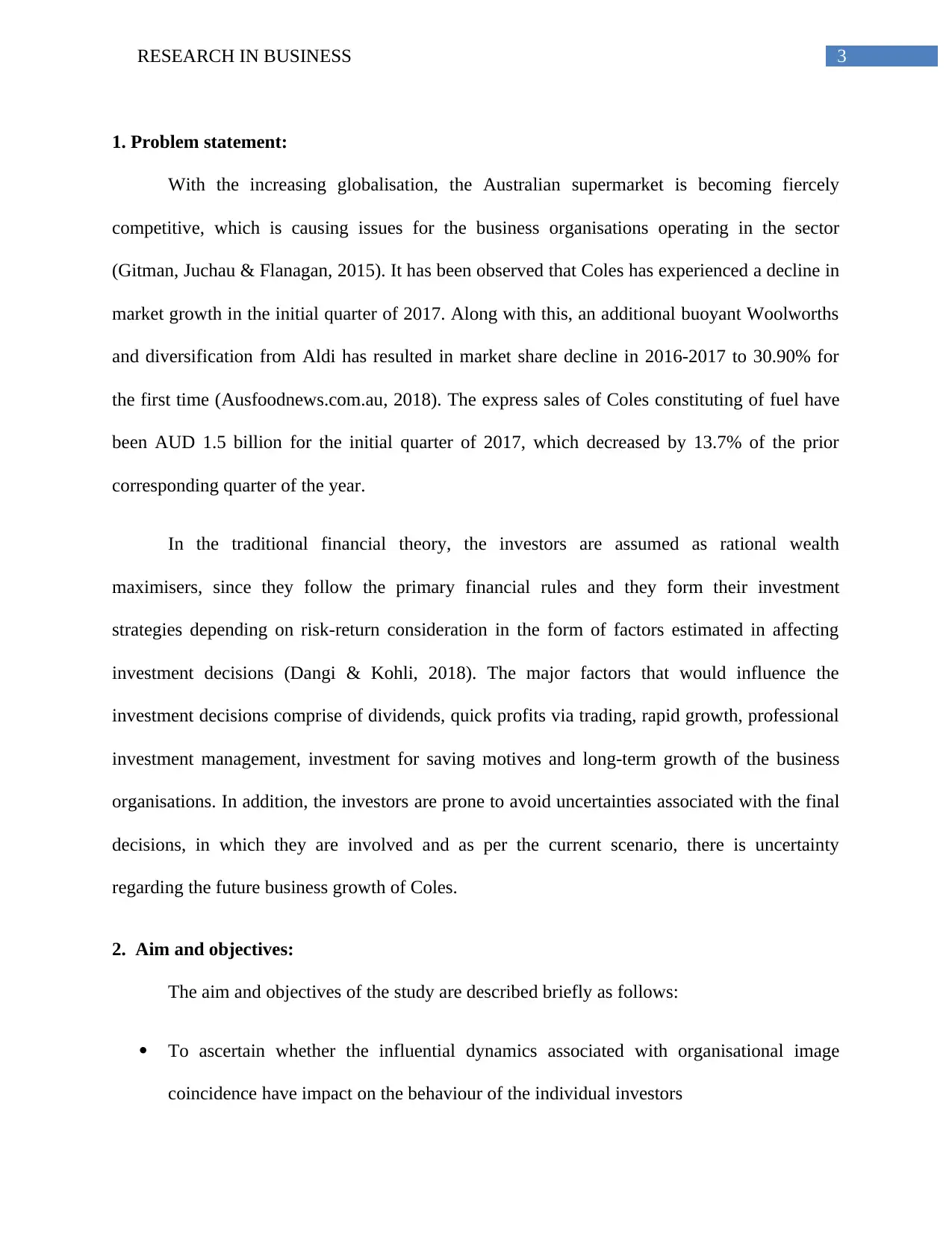
3RESEARCH IN BUSINESS
1. Problem statement:
With the increasing globalisation, the Australian supermarket is becoming fiercely
competitive, which is causing issues for the business organisations operating in the sector
(Gitman, Juchau & Flanagan, 2015). It has been observed that Coles has experienced a decline in
market growth in the initial quarter of 2017. Along with this, an additional buoyant Woolworths
and diversification from Aldi has resulted in market share decline in 2016-2017 to 30.90% for
the first time (Ausfoodnews.com.au, 2018). The express sales of Coles constituting of fuel have
been AUD 1.5 billion for the initial quarter of 2017, which decreased by 13.7% of the prior
corresponding quarter of the year.
In the traditional financial theory, the investors are assumed as rational wealth
maximisers, since they follow the primary financial rules and they form their investment
strategies depending on risk-return consideration in the form of factors estimated in affecting
investment decisions (Dangi & Kohli, 2018). The major factors that would influence the
investment decisions comprise of dividends, quick profits via trading, rapid growth, professional
investment management, investment for saving motives and long-term growth of the business
organisations. In addition, the investors are prone to avoid uncertainties associated with the final
decisions, in which they are involved and as per the current scenario, there is uncertainty
regarding the future business growth of Coles.
2. Aim and objectives:
The aim and objectives of the study are described briefly as follows:
To ascertain whether the influential dynamics associated with organisational image
coincidence have impact on the behaviour of the individual investors
1. Problem statement:
With the increasing globalisation, the Australian supermarket is becoming fiercely
competitive, which is causing issues for the business organisations operating in the sector
(Gitman, Juchau & Flanagan, 2015). It has been observed that Coles has experienced a decline in
market growth in the initial quarter of 2017. Along with this, an additional buoyant Woolworths
and diversification from Aldi has resulted in market share decline in 2016-2017 to 30.90% for
the first time (Ausfoodnews.com.au, 2018). The express sales of Coles constituting of fuel have
been AUD 1.5 billion for the initial quarter of 2017, which decreased by 13.7% of the prior
corresponding quarter of the year.
In the traditional financial theory, the investors are assumed as rational wealth
maximisers, since they follow the primary financial rules and they form their investment
strategies depending on risk-return consideration in the form of factors estimated in affecting
investment decisions (Dangi & Kohli, 2018). The major factors that would influence the
investment decisions comprise of dividends, quick profits via trading, rapid growth, professional
investment management, investment for saving motives and long-term growth of the business
organisations. In addition, the investors are prone to avoid uncertainties associated with the final
decisions, in which they are involved and as per the current scenario, there is uncertainty
regarding the future business growth of Coles.
2. Aim and objectives:
The aim and objectives of the study are described briefly as follows:
To ascertain whether the influential dynamics associated with organisational image
coincidence have impact on the behaviour of the individual investors
⊘ This is a preview!⊘
Do you want full access?
Subscribe today to unlock all pages.

Trusted by 1+ million students worldwide
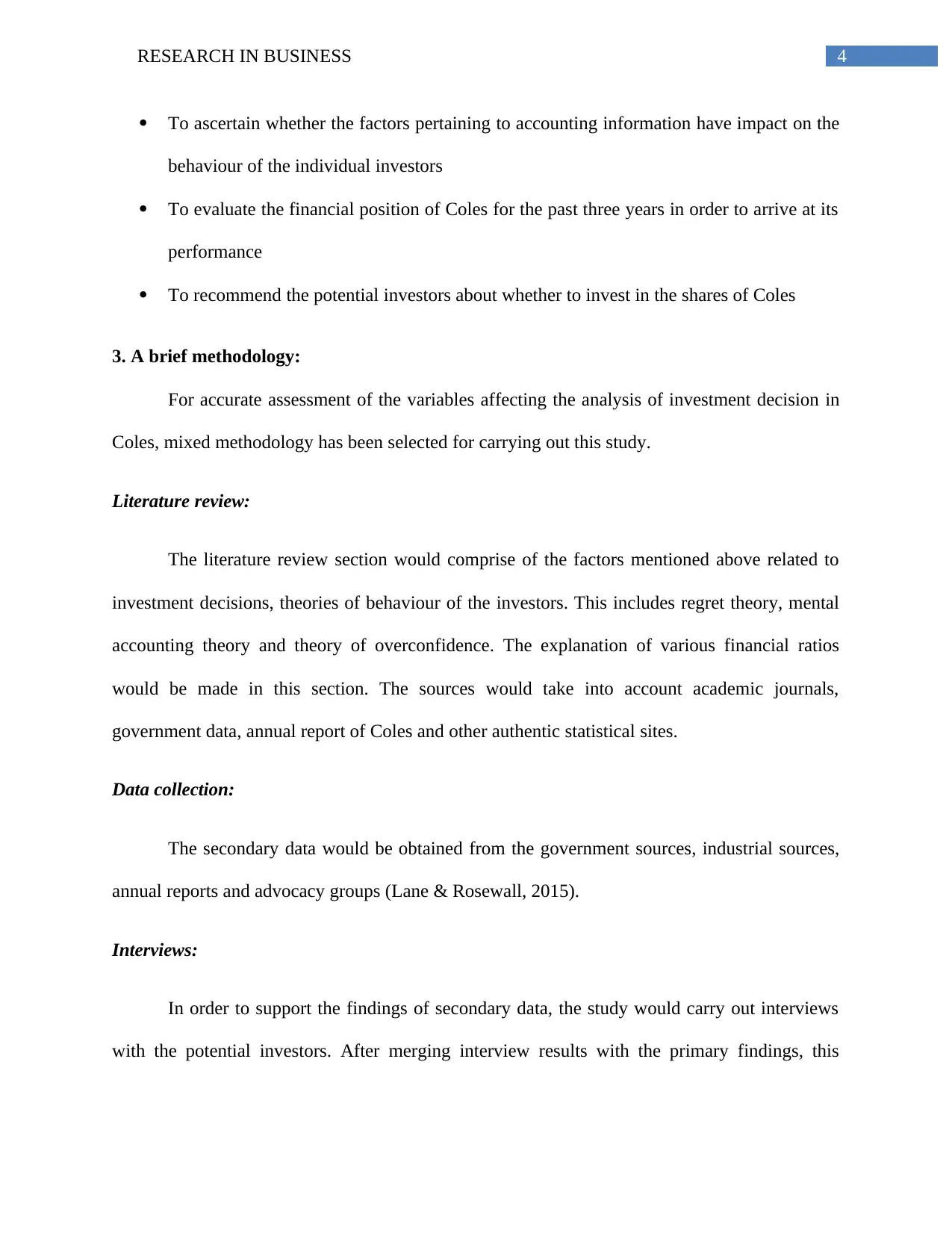
4RESEARCH IN BUSINESS
To ascertain whether the factors pertaining to accounting information have impact on the
behaviour of the individual investors
To evaluate the financial position of Coles for the past three years in order to arrive at its
performance
To recommend the potential investors about whether to invest in the shares of Coles
3. A brief methodology:
For accurate assessment of the variables affecting the analysis of investment decision in
Coles, mixed methodology has been selected for carrying out this study.
Literature review:
The literature review section would comprise of the factors mentioned above related to
investment decisions, theories of behaviour of the investors. This includes regret theory, mental
accounting theory and theory of overconfidence. The explanation of various financial ratios
would be made in this section. The sources would take into account academic journals,
government data, annual report of Coles and other authentic statistical sites.
Data collection:
The secondary data would be obtained from the government sources, industrial sources,
annual reports and advocacy groups (Lane & Rosewall, 2015).
Interviews:
In order to support the findings of secondary data, the study would carry out interviews
with the potential investors. After merging interview results with the primary findings, this
To ascertain whether the factors pertaining to accounting information have impact on the
behaviour of the individual investors
To evaluate the financial position of Coles for the past three years in order to arrive at its
performance
To recommend the potential investors about whether to invest in the shares of Coles
3. A brief methodology:
For accurate assessment of the variables affecting the analysis of investment decision in
Coles, mixed methodology has been selected for carrying out this study.
Literature review:
The literature review section would comprise of the factors mentioned above related to
investment decisions, theories of behaviour of the investors. This includes regret theory, mental
accounting theory and theory of overconfidence. The explanation of various financial ratios
would be made in this section. The sources would take into account academic journals,
government data, annual report of Coles and other authentic statistical sites.
Data collection:
The secondary data would be obtained from the government sources, industrial sources,
annual reports and advocacy groups (Lane & Rosewall, 2015).
Interviews:
In order to support the findings of secondary data, the study would carry out interviews
with the potential investors. After merging interview results with the primary findings, this
Paraphrase This Document
Need a fresh take? Get an instant paraphrase of this document with our AI Paraphraser
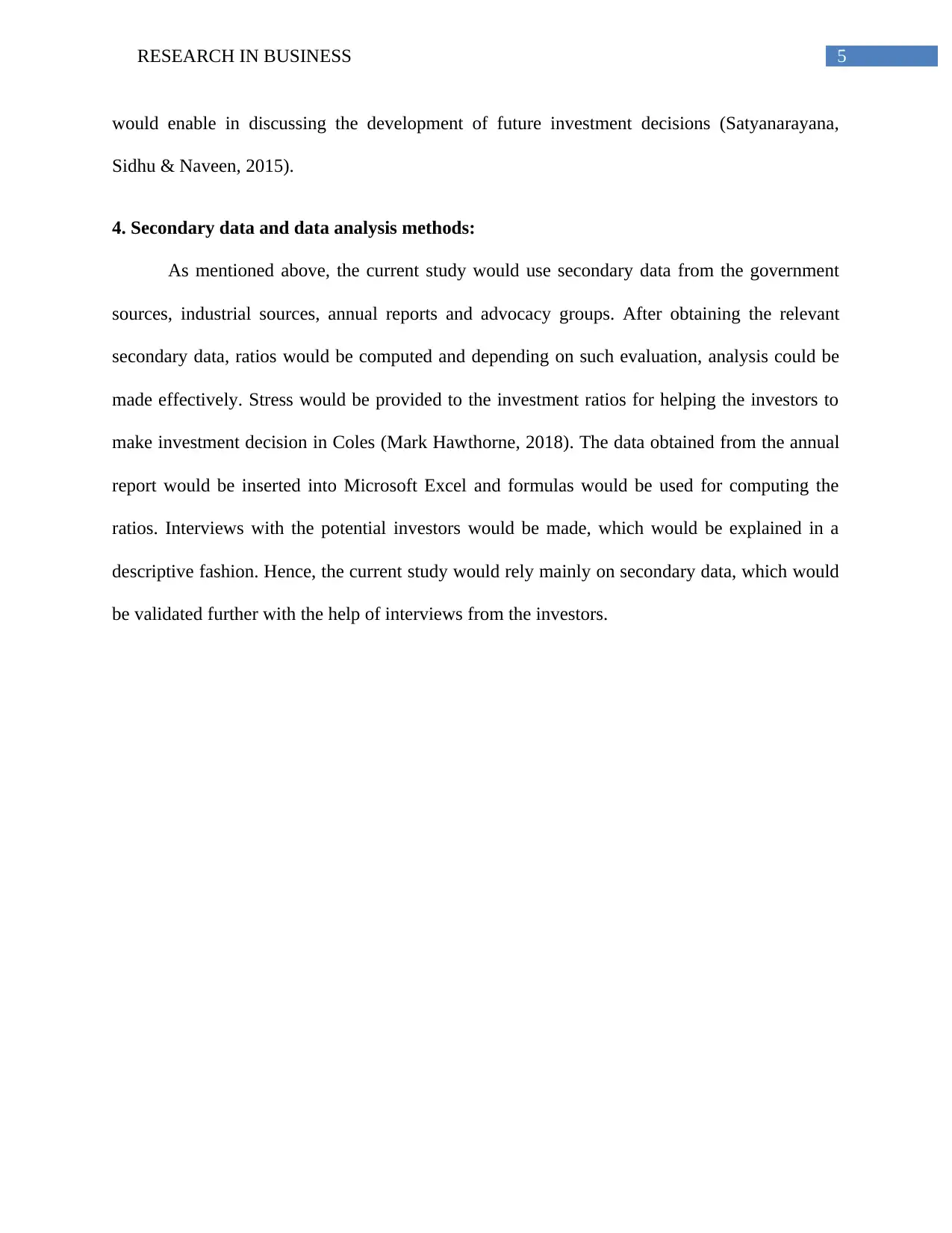
5RESEARCH IN BUSINESS
would enable in discussing the development of future investment decisions (Satyanarayana,
Sidhu & Naveen, 2015).
4. Secondary data and data analysis methods:
As mentioned above, the current study would use secondary data from the government
sources, industrial sources, annual reports and advocacy groups. After obtaining the relevant
secondary data, ratios would be computed and depending on such evaluation, analysis could be
made effectively. Stress would be provided to the investment ratios for helping the investors to
make investment decision in Coles (Mark Hawthorne, 2018). The data obtained from the annual
report would be inserted into Microsoft Excel and formulas would be used for computing the
ratios. Interviews with the potential investors would be made, which would be explained in a
descriptive fashion. Hence, the current study would rely mainly on secondary data, which would
be validated further with the help of interviews from the investors.
would enable in discussing the development of future investment decisions (Satyanarayana,
Sidhu & Naveen, 2015).
4. Secondary data and data analysis methods:
As mentioned above, the current study would use secondary data from the government
sources, industrial sources, annual reports and advocacy groups. After obtaining the relevant
secondary data, ratios would be computed and depending on such evaluation, analysis could be
made effectively. Stress would be provided to the investment ratios for helping the investors to
make investment decision in Coles (Mark Hawthorne, 2018). The data obtained from the annual
report would be inserted into Microsoft Excel and formulas would be used for computing the
ratios. Interviews with the potential investors would be made, which would be explained in a
descriptive fashion. Hence, the current study would rely mainly on secondary data, which would
be validated further with the help of interviews from the investors.
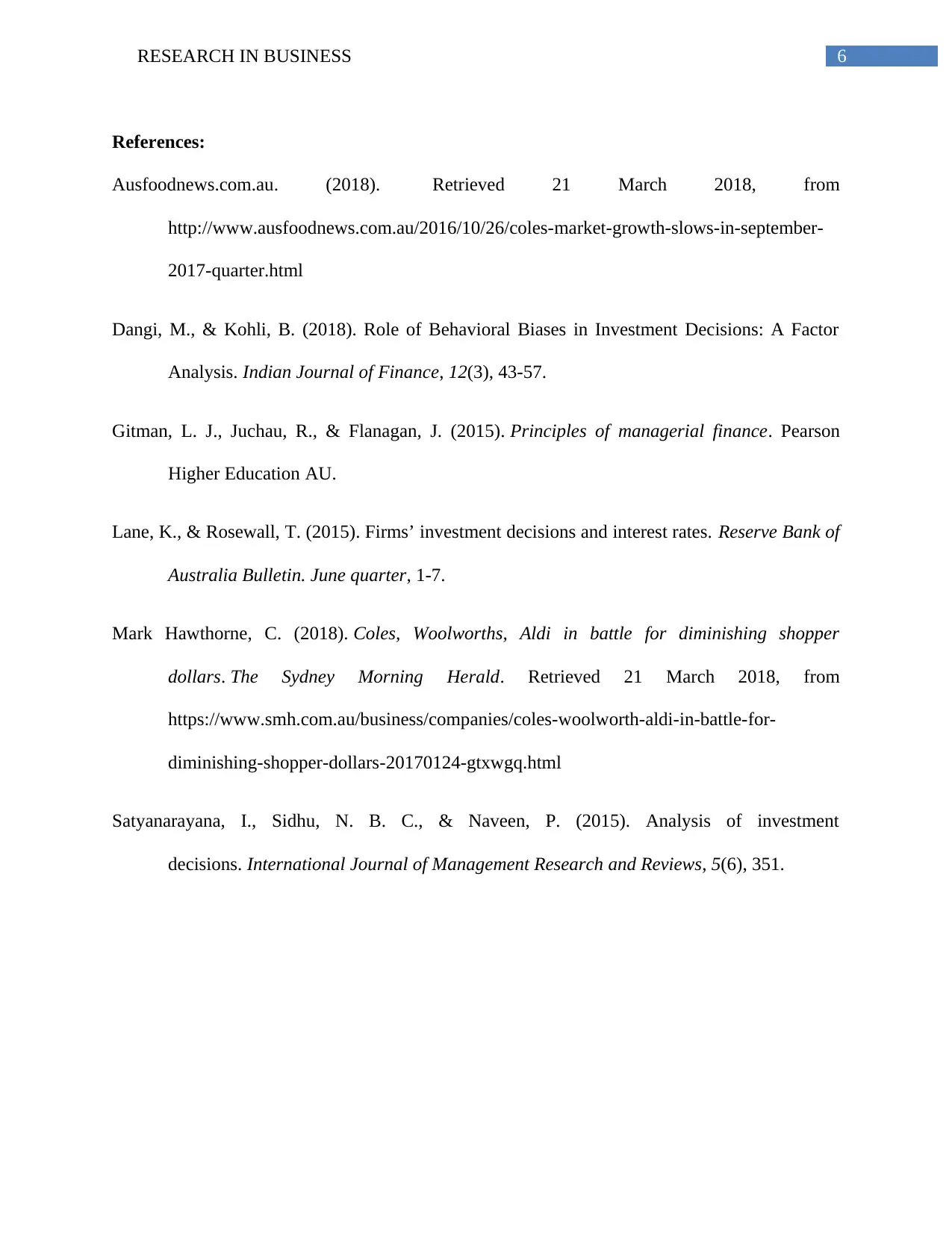
6RESEARCH IN BUSINESS
References:
Ausfoodnews.com.au. (2018). Retrieved 21 March 2018, from
http://www.ausfoodnews.com.au/2016/10/26/coles-market-growth-slows-in-september-
2017-quarter.html
Dangi, M., & Kohli, B. (2018). Role of Behavioral Biases in Investment Decisions: A Factor
Analysis. Indian Journal of Finance, 12(3), 43-57.
Gitman, L. J., Juchau, R., & Flanagan, J. (2015). Principles of managerial finance. Pearson
Higher Education AU.
Lane, K., & Rosewall, T. (2015). Firms’ investment decisions and interest rates. Reserve Bank of
Australia Bulletin. June quarter, 1-7.
Mark Hawthorne, C. (2018). Coles, Woolworths, Aldi in battle for diminishing shopper
dollars. The Sydney Morning Herald. Retrieved 21 March 2018, from
https://www.smh.com.au/business/companies/coles-woolworth-aldi-in-battle-for-
diminishing-shopper-dollars-20170124-gtxwgq.html
Satyanarayana, I., Sidhu, N. B. C., & Naveen, P. (2015). Analysis of investment
decisions. International Journal of Management Research and Reviews, 5(6), 351.
References:
Ausfoodnews.com.au. (2018). Retrieved 21 March 2018, from
http://www.ausfoodnews.com.au/2016/10/26/coles-market-growth-slows-in-september-
2017-quarter.html
Dangi, M., & Kohli, B. (2018). Role of Behavioral Biases in Investment Decisions: A Factor
Analysis. Indian Journal of Finance, 12(3), 43-57.
Gitman, L. J., Juchau, R., & Flanagan, J. (2015). Principles of managerial finance. Pearson
Higher Education AU.
Lane, K., & Rosewall, T. (2015). Firms’ investment decisions and interest rates. Reserve Bank of
Australia Bulletin. June quarter, 1-7.
Mark Hawthorne, C. (2018). Coles, Woolworths, Aldi in battle for diminishing shopper
dollars. The Sydney Morning Herald. Retrieved 21 March 2018, from
https://www.smh.com.au/business/companies/coles-woolworth-aldi-in-battle-for-
diminishing-shopper-dollars-20170124-gtxwgq.html
Satyanarayana, I., Sidhu, N. B. C., & Naveen, P. (2015). Analysis of investment
decisions. International Journal of Management Research and Reviews, 5(6), 351.
⊘ This is a preview!⊘
Do you want full access?
Subscribe today to unlock all pages.

Trusted by 1+ million students worldwide
1 out of 6
Related Documents
Your All-in-One AI-Powered Toolkit for Academic Success.
+13062052269
info@desklib.com
Available 24*7 on WhatsApp / Email
![[object Object]](/_next/static/media/star-bottom.7253800d.svg)
Unlock your academic potential
Copyright © 2020–2025 A2Z Services. All Rights Reserved. Developed and managed by ZUCOL.





